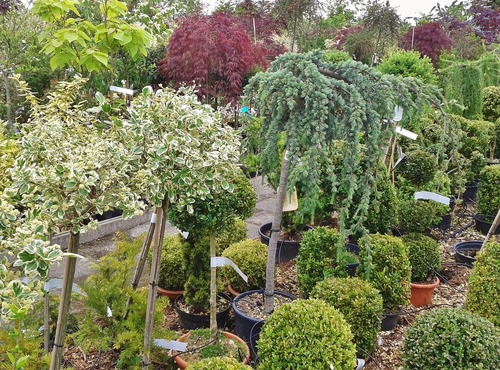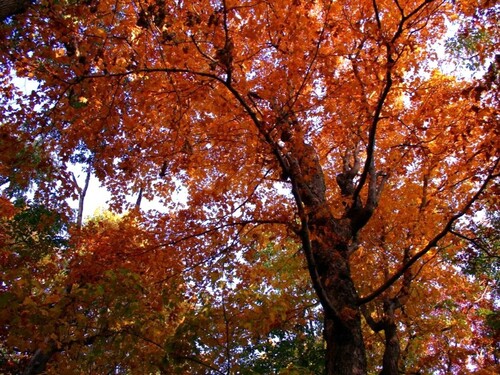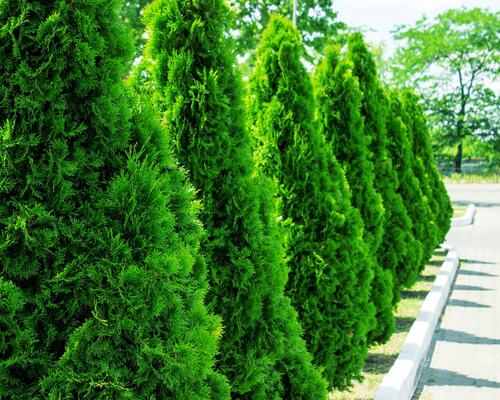The Best Trees to Consider for Your Backyard
Introduction
Choosing and planting new trees for your backyard landscaping is an exciting task, but how do you choose which trees to go with?
Depending on where you live and what you want your backyard to look like, you have hundreds and hundreds of different trees to choose from. They are all different colors, shapes, and sizes, so it can be an overwhelming choice.
We are going to discuss how you should go about making your choice and then share some of our favorite trees with you for inspiration.
Let’s get started!
How Do I Choose?

A Selection of Nursery Trees – Photo by CocoParisienne on Pixabay
So, how do you decide which trees you are going to go with? When weighing your options , there are a few different aspects and qualities you should consider.
First of all, consider who is going to be in your backyard. Do you have small children or pets that may hurt themselves on a tree with thorny branches or one that drops prickly items? Will they eat fruit that falls from the tree when they shouldn’t? If this is the case, steer clear of fruit trees and trees with anything sharp, like sweet gum or chestnut trees.
Also, consider how tall you want the trees to be. Some will grow past thirty feet in the air, while others stay smaller and easier to maintain.
Lastly, consider how much shade you want or need. There are trees labeled as shade trees that can cover quite a bit of the yard from the sun. However, if you still want lots of sun, you’ll want a tree with less branch span.
Our Top Favorite Backyard Trees
Now let’s take a look at a few of our favorite tree choices for backyard landscaping. Do you see any of your favorites on the list?
Sugar Maple

A Sugar Maple in Autumn – Photo from Wikimedia Commons
This tree most likely looks pretty familiar to you. The sugar maple is a gorgeous staple in North America and is loved by many.
Did you know this particular tree is the most common choice for a state tree? New York, West Virginia, Wisconsin, and Vermont have all claimed this tree to represent their state.
This tree is considered to be both a shade tree and an ornamental tree . Basically, this means that the tree is used for its incredible beauty and the vast amount of shade it can provide with its branches and leaves.
There are many different reasons why we love this tree.
The sugar maple puts on an incredible show in the fall. Its leaves turn vibrant, gorgeous shades of orange, yellow, and red. During the spring and summer, this tree has lovely dark green leaves as well. So no matter what time of year you are looking at it, there are beautiful colors to behold.
We also love that this tree has such a dense crown, meaning you get incredible shade in your yard out of it.
Other aspects of this tree that are important to note include the fact that a sugar maple tree will produce small yellow-green flowers that curve downward in long stems during the months of April and May.
They also drop pairs of winged seeds that are about an inch and a half long. These will mature in September and October and are produced annually. However, they only have really heavy crops every two to five years.
This tree should not be planted in a confined space, as it will grow to be enormous. It should also not be planted where salt is an issue in the ground.
Red Oak

Autumn Colors on a Red Oak Tree – Photo from Wikimedia Commons
Next up, we have the glorious red oak tree.
This particular tree has been referred to by the naturalist Joseph S. Illick as “one of the handsomest, cleanest, and stateliest trees in North America.” We would definitely agree with him. It is considered to be a national treasure and is known for its hardiness in urban areas as well as its gorgeous fall color and its value to wildlife. It is also New Jersey’s state tree.
Red oak has a lot of interesting aspects to keep in mind if you want it in your backyard.
These trees grow very fast. A Red Oak will grow more than two feet per year for a decade. That is twenty feet in ten years, which is much faster than many other trees grow.
Just like sugar maple trees, these trees provide gorgeous, vibrant colors in the fall. They will turn a bright red in autumn and light up your entire backyard.
Red oak trees provide pale yellow-green catkins in April and May. They also yield acorns that are round and up to an inch long with a saucer-like cap.
These are also shade trees, like the sugar maple. So if you are looking for more shade in your backyard, this is an excellent choice.
This tree is also very well known for how well it tolerates pollution and compacted soil, meaning that it will do better than most trees in an urban setting like a heavily populated city.
‘Green Giant’ Arborvitae

A Row of Arborvitae Lining a Curb
Last, but certainly not least, we have the “green giant,” also known as the arborvitae tree .
This is an evergreen tree that is extremely large and fast growing. It can grow up to three feet per year until it is mature. It has an incredibly rich green color that lasts through all four seasons of the year, only darkening slightly in the winter.
If you want a plant that will serve as a privacy barrier between you and your neighbors, look no further. This tree is incredibly dense and tall, making it the perfect fence. On top of that, it is resistant to wind once it is established and can also withstand incredibly heavy snow or ice.
These trees require almost no pruning or tree care at all but can be easily sheared if necessary.
It is recommended that if you are planning a line of them, they are spaced five to six feet apart to allow them to grow.
The green giant is a public domain tree, which simply means that anyone can propagate it from cuttings.
This tree has no serious pest or disease issues and is incredibly resistant to browsing by deer.
It also has tiny, glossy green leaves that will pack closely together in rows that overlap and yields six inch long pine cones that will stay green until the winter, when they turn brown. The leaves will actually release a pleasant smell if they are squeezed.
Happy Picking!
Now that you are fully prepared to choose trees for your backyard, we wish you luck on your journey. If you do have additional questions concerning the best trees for your area or how to plant them, feel free to contact us .
Which tree on the list is your favorite?
Originally published on July 7, 2018.


